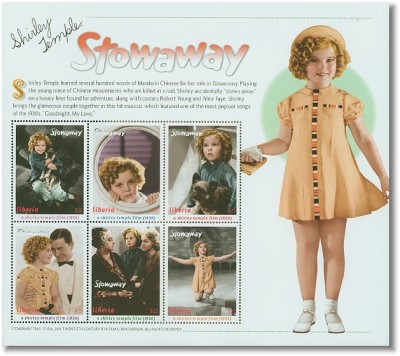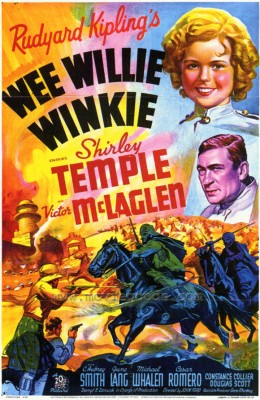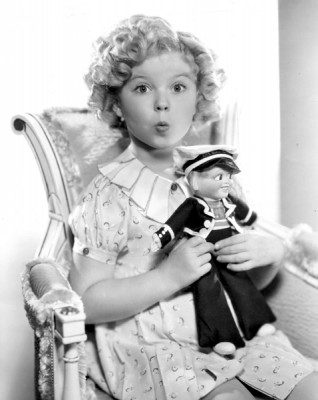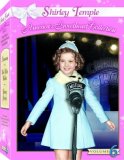| Reviews & Columns |
|
Reviews DVD TV on DVD Blu-ray 4K UHD International DVDs In Theaters Reviews by Studio Video Games Features Collector Series DVDs Easter Egg Database Interviews DVD Talk Radio Feature Articles Columns Anime Talk DVD Savant Horror DVDs The M.O.D. Squad Art House HD Talk Silent DVD
|
DVD Talk Forum |
|
|
| Resources |
|
DVD Price Search Customer Service #'s RCE Info Links |
|
Columns
|
|
|
Shirley Temple - America's Sweetheart Collection, Volume 6 (Stowaway / Wee Willie Winkie / Young People)
Watching the three films in this set - the others are Stowaway (1936) and Young People (1940) - brought back a flood of childhood memories and, truth be told, I was surprised at just how good these films are and how exceptionally talented and adorable Shirley Temple was at her peak. If you can get past all the pink and white ribbon packaging, the best of these movies are in no way limited to an audience of little girls and their mothers.
Stowaway is the epitome of the "star vehicle" in the good sense, and make no mistake about it: in 1936 Shirley Temple unquestionably was the biggest star in the country. Bigger than Gable, Fred Astaire & Ginger Rogers, bigger than Joan Crawford and Gary Cooper - topping Quigley's Annual List of Box Office Champions four years in a row, from 1935-1938, a feat matched by just one other performer.*
The film is predictable but immensely entertaining, shamelessly but forgivably manipulative. For contemporary audiences in the grip of the Great Depression, it must have been just about the perfect escapist entertainment. The picture opens in "Sanchow," in Mainland China, where eight-year-old orphan Barbara Stewart (Shirley Temple), better known to all by her Chinese name Ching-Ching, is secretly moved to Shanghai when her small village is threatened by bandits. She's separated from her dishonest boatman (who also steals her money) but, wandering through Shanghai with her dog Mr. Wu, Ching-Ching meets breezy alcoholic playboy Tommy Randall (Robert Young), a lazy American millionaire.
Tommy is infatuated with Ching-Ching and secretly delighted when, purely by accident, she falls asleep in his Dusenberg's rumble seat and the car is hoisted aboard a luxury liner bound for San Francisco (via a curiously serpentine route all over Southeast Asia). On board Ching-Ching also becomes friendly with Susan Parker (Alice Faye), en route to Bangkok with her future mother-in-law, boorish Mrs. Hope (Helen Westley), to meet Richard (Allan, later "Rocky" Lane), Susan's assistant bank manager fiancé, a real mamma's boy.
As often happens in Shirley Temple movies, Ching-Ching is the catalyst for Tommy's reformation - from boozy, irresponsible playboy to loving and responsible parent, with Ching-Ching likewise playing matchmaker to Tommy and Susan.
Predictability aside, I was taken aback by the Stowaway's incredible charm, Temple's polished yet never cloying performance, and the general handsomeness of the production. Produced concurrently with Fox's "Charlie Chan" series, Stowaway is far more lavish; reportedly it cost about $500,000, probably something like three times the cost of the average Chan. Though a lot of Shanghai is represented by crude rear-projection shots, Sanchow is quite an elaborate backlot set and some of the Shanghai and Hong Kong streets are expansive and crammed with costumed extras.
Shirley's great. There are the usual kinds of things one expects in a Shirley Temple movie, such as the incredibly sweet scene where she sings a lullaby ("Goodnight, My Love") to herself when Tommy and his butler (Arthur Treacher, natch) aren't up to the task. Later in the film, she appears in a talent contest - MC'd by an actor identified in the credits as "Honorable Wu" (no relation to Shirley's dog, presumably) - with Shirley singing "You've Got to S-M-I-L-E to Be H-A-double P-Y," a number incorporating funny impressions of Al Jolson and Eddie Cantor. (What did my sister and I make of this when we were seven and eight years old?) For the Big Finish Ching-Ching imitates Ginger Rogers by dancing with a tiny Fred Astaire mannequin, a surreal moment that looks like Shirley Temple stepping out with the ventriloquist dummy from Dead of Night.
Most impressive of all Temple actually speaks Mandarin for much of the film, carrying on conversations with various Chinese when Tommy's politically incorrect pidgin-speak goes nowhere. Temple presumably learned these lines phonetically, but she takes to it like a duck to water, speaking Chinese with almost no American accent. (Ching-Ching also engages in cute Charlie Chan-esque aphorisms: "Friendship is like a shelter from the rains of trouble," etc.)
Really, Stowaway's single flaw is that its last act is dragged out a bit too long, and by the fatal miscasting of J. Edward Bromberg as a loveable family court judge who sets everything right at the end. The role called for a Harry Carey or Samuel Hinds type, hardly an actor who specialized in sinister types like Bromberg, the least cuddly of Fox's contract players, even less so than Peter Lorre!
Seemingly equal parts of John Ford, Shirley Temple, the adventure of Gunga Din (made into a film of its own two years later), and the racial/religious intolerance drama of A Passage to India, (Rudyard Kipling's) Wee Willie Winkie is something of a jumble of concerns, but the results are still eminently entertaining.
In 1897, at India's northern border, the widowed, destitute American daughter-in-law of British Raj Colonel Williams (C. Aubrey Smith) moves to his remote outpost, her precocious daughter, Priscilla (Shirley Temple) in tow. They arrive just as infamous rebel chieftain Khoda Khan (Cesar Romero) is caught trying to slip away with a shipment of stolen rifles. Unaware of his notoriety, she returns his (explicitly Islamic) talisman, which surprises the outlaw so used to suspicion and hatred from the white infidels.
Soon enough, Priscilla melts the heart of her stuffy grandfather while befriending practically everyone in the Highland regiment, especially Sgt. Donald McDuff (Victor McLaglen), a very John Fordian tough guy whose idea of paradise is instigating drunken brawls. Burly McDuff's relationship with the diminutive Priscilla is the heart of the picture, he all but adopting her as his own and teaching the enthusiastic American child British military discipline.
As with Stowaway, Wee Willie Winkie is lavishly produced, mostly on an expansive outpost exterior set built at Iverson Ranch in Chatsworth, and the recreations of North India are surprisingly good. Ford's fondness for broad, rowdy humor among soldiers was always something this reviewer never much cared for (and overdone even in Ford's masterpiece, The Searchers) and a subplot involving Joyce's romance with a lieutenant Col. Williams dislikes, "Coppy" Brandes (Michael Whalen), is gratingly superfluous.
Though made immediately after Stowaway, one can also see Temple having peaked as a child star. For maybe the first time in her career, she's given lines that play slightly younger than she actually was, as if Fox's executives were trying to lock her into the age of eight for a few more years, rather than let her act her true age. Though 100% genuine in Stowaway here she's just a little self-consciously cute.
But the film is loaded with good material, including a beautifully directed and acted death scene near the climax. The plea for racial/religious understanding, with naïve Priscilla venturing into forbidden territory beyond the border to talk Khan out of this - gosh! - silly old war, works even today, though Temple's scenes with Romero were bettered a few years later in The Little Princess (1939), when he played a friendly Asian Indian neighbor. But the climax is undeniably suspenseful and its resolution most satisfying.
Somewhat better than its reputation would suggest, Young People (1940) was Shirley Temple's last film as a Fox star; she'd go on to appear in another 14 pictures of varying quality before retiring from films at 21 (!) in 1949. Though corny and predictable, Young People is hard not to enjoy; like the Vaudevillian family at its center, it's eager to please.
When an old woman (Mary Gordon, Mrs. Hudson of the Sherlock Holmes movies), leaves a basket containing tiny infant Wendy O'Hara, lifelong showbiz couple Joe and Kit Ballantine (Jack Oakie and Joan Greenwood) instantly decide to adopt her.
In a clever use of doubles and stock footage from early Shirley Temple movies, Wendy soon joins her parents onstage, singing "The Beaches of Waikiki" and "Daddy, Take a Bow," actually integrated footage from Curly Top (1935) and Stand Up and Cheer! (1935). It's effective and almost creepy, like the use of discarded Peter Sellers scenes in Trail of the Pink Panther (1982), only Shirley ain't dead.
Eventually the real, 12-year-old Shirley appears with her adopted mom and dad for a terrific number called "Fifth Avenue," the fourth song in the first ten minutes. But Joe and Kit have already made up their minds to retire, to raise Shirley in a normal, less frenetic environment on a New England farm, and after bidding a sweet farewell to their loyal audience, the movie shifts gears into The Egg and I territory.
It's here where Young People starts to go downhill. Led by sanctimonious school principal Hester Appleby (Kathleen Howard, previously brilliant as W.C. Fields' domineering wife), the conservative small town community has no use for disreputable show business types. They treat them like second-class citizens and with much eye-winking appoint Joe to head their Chamber of Commerce, only Joe doesn't realize the joke's on him.
Though there was a time earlier in the century when showbiz folk were looked upon with suspicion and disdain by small town municipalities, by 1940 Burlesque and Vaudeville were pretty much dead already anyway - the Ballantines are performing in big movie palaces before the movie - and the local yokel stuffiness shown in Young People must have seemed pretty hokey even in 1940.
Though the film gives Shirley about three crying scenes too many, at least she's otherwise allowed to act her age. She's still a fine actress, and though her singing voice can't hold a candle to near-contemporaries Judy Garland and Deanna Durbin she's quite a good tap dancer and "Fifth Avenue" is a musical highlight.
Greenwood also gets to stretch her trademark rubbery legs, with signature kicks that repeatedly threaten to whack her in the face. Oakie is well-cast as the breezy, well-meaning but somewhat clueless Vaudevillian. He gets to sing "I Wouldn't Take a Million" while driving their convertible, the kind of number that's hard to enjoy because he's so busy serenading Shirley and Greenwood, gazing into their eyes, one expects a head-on collision any minute and you're busy shouting "Look at the road, Jack!"
Unlike Temple's previous films, Young People has the air of a moderate "B" rather than the first-class treatment her films usually got. The Blue Bird, Fox's answer to The Wizard of Oz and Temple's previous film, was a major flop, partly because Shirley's character was so nasty and unsympathetic. Yet as Shirley's swan song, Young People is hardly a disaster; it's a modest, flawed, but enjoyable trifle.
Video & Audio
All three films are in their original full-frame format, with English and Spanish Dolby Digital 2.0 mono tracks with optional subtitles in English, French, and Spanish. Song lyrics are subtitled also. The audio and video are generally in fine shape, the one exception being a weird reel-long flaw on Young People in which a dot-like shadowy blemish appears in the middle-left of the frame for approximately 10 minutes about a third into the film.
Wee Willie Winkie is presented in its complete 100-minute version, with about 25 minutes restored. A restoration demonstration helpfully explains that the transfer was compiled mainly from a 1943 nitrate lavender master positive owned by Fox, and a 1960 safety print held by the UCLA Film & Television Archives.
The disc is a flipper, with the film in standard black and white on one side, and with the original tinting and toning on the other, each single-layered. (The tinting is moderately effective, with Sepia used to emphasize both the hot Indian heat and its late Victorian era setting.)
Extra Features
Except for the tinted version of Wee Willie Winkie and the restoration comparison, the only other supplements are a few trailers. The one for Young People is textless.
Parting Thoughts
It's somehow appropriate that in Shirley's last Fox film she's cast as a 12-year-old veteran of show business, reading Variety and up on all the lingo. For this reviewer Shirley Temple - America's Sweetheart Collection, Volume 6 was a pleasant surprise, three very different films each quite worthwhile in its own way. Highly Recommended.
* Did you guess Bing Crosby? I didn't.
Film historian Stuart Galbraith IV's latest books, Japanese Cinema and The Toho Studios Story, are now available for pre-order.
|
| Popular Reviews |
| Sponsored Links |
|
|
| Sponsored Links |
|
|
| Release List | Reviews | Shop | Newsletter | Forum | DVD Giveaways | Blu-Ray | Advertise |
|
Copyright 2024 DVDTalk.com All Rights Reserved. Legal Info, Privacy Policy, Terms of Use,
Manage Preferences,
Your Privacy Choices | |||||||

















